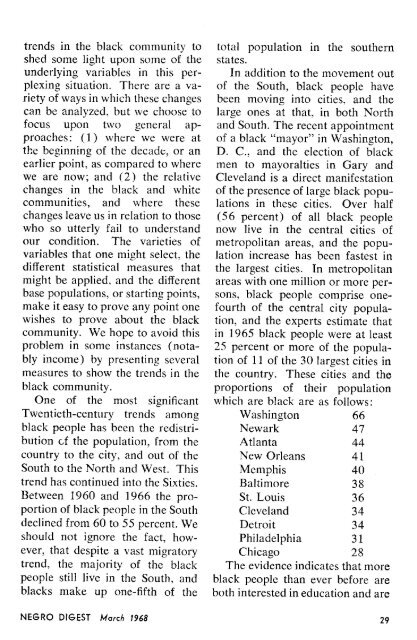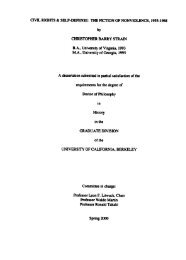Negro Digest - Freedom Archives
Negro Digest - Freedom Archives
Negro Digest - Freedom Archives
You also want an ePaper? Increase the reach of your titles
YUMPU automatically turns print PDFs into web optimized ePapers that Google loves.
trends in the black community to<br />
shed some light upon some of the<br />
underlying variables in this perplexing<br />
situation . There are a variety<br />
of ways in which these changes<br />
can be analyzed, but we choose to<br />
focus upon two general approaches<br />
: (1) where we were at<br />
the beginning of the decade, or an<br />
earlier point, as compared to where<br />
we are now ; and ( 2 ) the relative<br />
changes in the black and white<br />
communities, and where these<br />
changes leave us in relation to those<br />
who so utterly fail to understand<br />
our condition . The varieties of<br />
variables that one might select, the<br />
different statistical measures that<br />
might be applied, and the different<br />
base populations, or starting points,<br />
make it easy to prove any point one<br />
wishes to prove about the black<br />
community . We hope to avoid this<br />
problem in some instances (notably<br />
income) by presenting several<br />
measures to show the trends in the<br />
black community .<br />
One of the most significant<br />
Twentieth-century trends among<br />
black people ha.s been the redistribution<br />
cf the population, from the<br />
country to the city, and out of the<br />
South to the North and West . This<br />
trend has continued into the Sixties .<br />
Between 1960 and 1966 the proportion<br />
of black people in the South<br />
declined from 60 to 55 percent . We<br />
should not ignore the fact, however,<br />
that despite a vast migratory<br />
trend, the majority of the black<br />
people still live in the South, and<br />
blacks make up one-fifth of the<br />
NEGRO DIGEST March 1968<br />
total population in the southern<br />
states .<br />
In addition to the movement out<br />
of the South, black people have<br />
been moving into cities, and the<br />
large ones at that, in both North<br />
and South . The recent appointment<br />
of a black "mayor" in Washington,<br />
D . C ., and the election of black<br />
men to mayoralties in Gary and<br />
Cleveland is a direct manifestation<br />
of the presence of large black populations<br />
in these cities . Over half<br />
(56 percent) of all black people<br />
now live in the central cities of<br />
metropolitan areas, and the population<br />
increase has been fastest in<br />
the largest cities . In metropolitan<br />
areas with one million or more persons,<br />
black people comprise onefourth<br />
of the central city population,<br />
and the experts estimate that<br />
in 1965 black people were at least<br />
25 percent or more of the population<br />
of 11 of the 30 largest cities in<br />
the country . These cities and the<br />
proportions of their population<br />
which are black are as follows :<br />
Washington 66<br />
Newark 47<br />
Atlanta 44<br />
New Orleans 41<br />
Memphis 40<br />
Baltimore 38<br />
St. Louis 36<br />
Cleveland 34<br />
Detroit 34<br />
Philadelphia 31<br />
Chicago 28<br />
The evidence indicates that more<br />
black people than ever before are<br />
both interested in education and are<br />
29
















